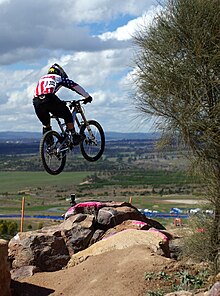
Back Descens de BTT Catalan Downhill Czech Downhill German Descenso BTT Spanish Downhill Estonian Jaitsiera (txirrindularitza) Basque Alamäkiajo Finnish Descente (cyclisme) French דאון היל HE Fjallabrun Icelandic
 |


Downhill mountain biking (DH) is a style of mountain biking practiced on steep, rough terrain that often features jumps, drops, rock gardens and other obstacles. Jumps can be up to and including 12 meters (39 feet), and drops can be greater than 3 meters (10 feet).
The rider commonly travels to the point of descent via a ski lift or automobile, since the weight of the downhill mountain bike often precludes any serious climbing. In this context, the use of a motorized vehicle or device does not make DH a motorized sport.
Riders must possess a unique combination of total body strength, aerobic and anaerobic fitness, and the acceptance of a relatively high risk of incurring serious permanent injuries.
Downhill bikes are heavier and stronger than other mountain bikes and feature front and rear suspension with over 8 inches (20 cm) of travel, to glide quickly over rocks and tree roots. In competitive races, a continuous course is defined on each side by a strip of tape. Depending on the format, riders have a single or double attempt to reach the finish line as fast as possible, while remaining between the two tapes designating the course. Riders must choose their line by compromising between the shortest possible line and the line that can be traveled at the highest speed. If a rider leaves the course by crossing or breaking the tape they must return to the course at the point of exit, unless they do not gain a time advantage from crossing the tape, in which case they can continue with their run.[citation needed]
Riders start at intervals, often seeded from slowest to fastest, and courses typically take two to five minutes to complete with winning margins being often less than a second. Riders are timed with equipment similar to that used in downhill skiing.[1]
- ^ "Mountain Bike Action: Inside the Pros' Bikes". Retrieved 21 May 2009.